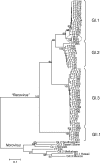Genetic diversity and histo-blood group antigen interactions of rhesus enteric caliciviruses
- PMID: 20554772
- PMCID: PMC2919043
- DOI: 10.1128/JVI.00630-10
Genetic diversity and histo-blood group antigen interactions of rhesus enteric caliciviruses
Abstract
Recently, we reported the discovery and characterization of Tulane virus (TV), a novel rhesus calicivirus (CV) (T. Farkas, K. Sestak, C. Wei, and X. Jiang, J. Virol. 82:5408-5416, 2008). TV grows well in tissue culture, and it represents a new genus within Caliciviridae, with the proposed name of Recovirus. We also reported a high prevalence of CV antibodies in macaques of the Tulane National Primate Research Center (TNPRC) colony, including anti-norovirus (NoV), anti-sapovirus (SaV), and anti-TV (T. Farkas, J. Dufour, X. Jiang, and K. Sestak, J. Gen. Virol. 91:734-738, 2010). To broaden our knowledge about CV infections in captive nonhuman primates (NHP), 500 rhesus macaque stool samples collected from breeding colony TNPRC macaques were tested for CVs. Fifty-seven (11%) samples contained recovirus isolates. In addition, one NoV was detected. Phylogenetic analysis classified the recovirus isolates into two genogroups and at least four genetic types. The rhesus NoV isolate was closely related to GII human NoVs. TV-neutralizing antibodies were detected in 88% of serum samples obtained from primate caretakers. Binding and plaque reduction assays revealed the involvement of type A and B histo-blood group antigens (HBGA) in TV infection. Taken together, these findings indicate the zoonotic potential of primate CVs. The discovery of a genetically diverse and prevalent group of primate CVs and remarkable similarities between rhesus enteric CVs and human NoVs opens new possibilities for research involving in vitro and in vivo models of human NoV gastroenteritis.
Figures






Similar articles
-
Detection of norovirus-, sapovirus- and rhesus enteric calicivirus-specific antibodies in captive juvenile macaques.J Gen Virol. 2010 Mar;91(Pt 3):734-8. doi: 10.1099/vir.0.015263-0. Epub 2009 Nov 4. J Gen Virol. 2010. PMID: 19889933 Free PMC article.
-
Characterization of a rhesus monkey calicivirus representing a new genus of Caliciviridae.J Virol. 2008 Jun;82(11):5408-16. doi: 10.1128/JVI.00070-08. Epub 2008 Apr 2. J Virol. 2008. PMID: 18385231 Free PMC article.
-
Experimental inoculation of juvenile rhesus macaques with primate enteric caliciviruses.PLoS One. 2012;7(5):e37973. doi: 10.1371/journal.pone.0037973. Epub 2012 May 30. PLoS One. 2012. PMID: 22666426 Free PMC article.
-
Role of histo-blood group antigens in primate enteric calicivirus infections.World J Virol. 2014 Aug 12;3(3):18-21. doi: 10.5501/wjv.v3.i3.18. World J Virol. 2014. PMID: 25392814 Free PMC article. Review.
-
Rhesus enteric calicivirus surrogate model for human norovirus gastroenteritis.J Gen Virol. 2015 Jul;96(Pt 7):1504-14. doi: 10.1099/jgv.0.000020. Epub 2014 Dec 12. J Gen Virol. 2015. PMID: 25502652 Review.
Cited by
-
Cryo-EM structure of a novel calicivirus, Tulane virus.PLoS One. 2013;8(3):e59817. doi: 10.1371/journal.pone.0059817. Epub 2013 Mar 22. PLoS One. 2013. PMID: 23533651 Free PMC article.
-
Molecular detection of murine noroviruses in laboratory and wild mice.Vet Microbiol. 2012 Dec 7;160(3-4):463-7. doi: 10.1016/j.vetmic.2012.06.002. Epub 2012 Jun 13. Vet Microbiol. 2012. PMID: 22748629 Free PMC article.
-
Non-Human Primate Models of Enteric Viral Infections.Viruses. 2018 Oct 5;10(10):544. doi: 10.3390/v10100544. Viruses. 2018. PMID: 30301125 Free PMC article. Review.
-
Co-culture with Enterobacter cloacae does not Enhance Virus Resistance to Thermal and Chemical Treatments.Food Environ Virol. 2019 Sep;11(3):238-246. doi: 10.1007/s12560-019-09381-5. Epub 2019 Mar 26. Food Environ Virol. 2019. PMID: 30915682
-
Virucidal Efficacy of Olanexidine Gluconate as a Hand Antiseptic Against Human Norovirus.Food Environ Virol. 2020 Jun;12(2):180-190. doi: 10.1007/s12560-020-09422-4. Epub 2020 Mar 2. Food Environ Virol. 2020. PMID: 32124244 Free PMC article.
References
-
- Apoil, P. A., F. Roubinet, S. Despiau, R. Mollicone, R. Oriol, and A. Blancher. 2000. Evolution of alpha 2-fucosyltransferase genes in primates: relation between an intronic Alu-Y element and red cell expression of ABH antigens. Mol. Biol. Evol. 17:337-351. - PubMed
-
- Bucardo, F., E. Kindberg, M. Paniagua, A. Grahn, G. Larson, M. Vildevall, and L. Svensson. 2009. Genetic susceptibility to symptomatic norovirus infection in Nicaragua. J. Med. Virol. 81:728-735. - PubMed
Publication types
MeSH terms
Substances
Grants and funding
LinkOut - more resources
Full Text Sources
Other Literature Sources

